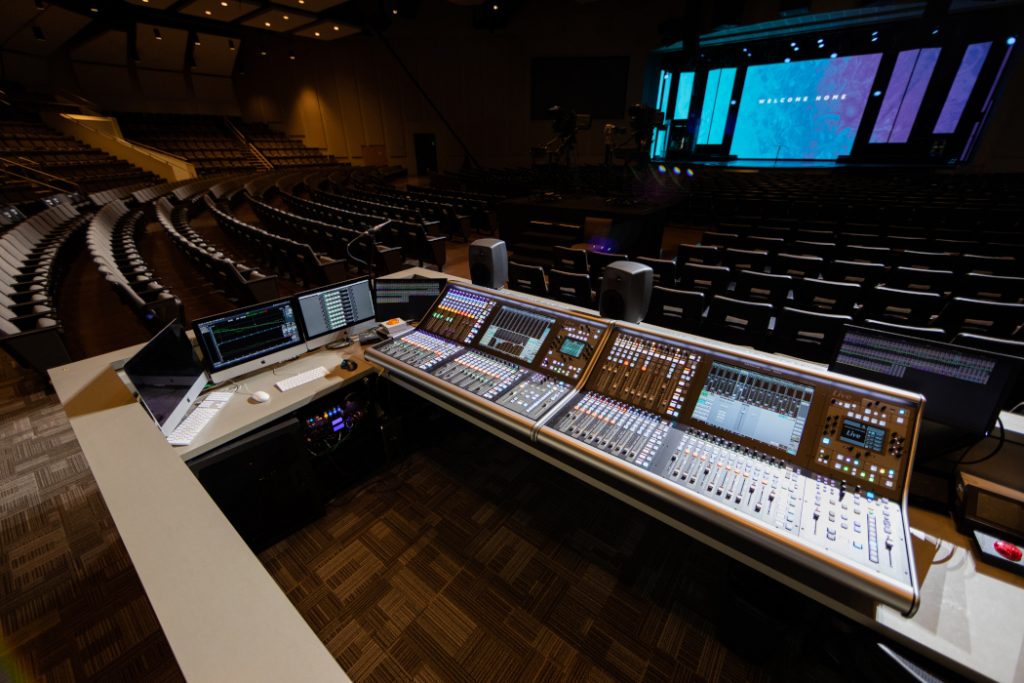One of the biggest challenges for a successful multi-campus church is ensuring that its audio and video technology is truly equal to the needs of a growing ministry. Many rapidly growing churches eventually find that their existing AV technology is limiting what they are capable of, and as their ideas for worship programming become more ambitious, the answer to the question “Can we do this?” is too often a resounding “No.”
Alabama-based Church of the Highlands is one such growing ministry that wanted to overcome the technical limitations of its existing systems in order to create a worship experience that matched its growing ambitions. To that end, the church recently invested in a large-scale audio upgrade at its Grants Mill AL broadcast campus, and it is currently in the planning stages for an accompanying video upgrade.
The Grants Mill broadcast campus seats 2,600 in a fan-shaped layout with stadium-style seating in the rear of the room. In addition to the broadcast campus, Church of the Highlands is composed of 19 satellite campuses located throughout Central Alabama. Each week, the satellite campuses host their own local worship services, and the satellite campuses also stream a spoken-word teaching segment delivered at the broadcast campus.
As Church of the Highlands’ Audio Director, Marc Johnson, described it, “Highlands follows the one-church-many-locations multisite model. Local worship [is] done at each campus, and the main broadcast location [originates] the message content for all campuses. There are local campus pastors and local worship teams at each of the [19 satellites]. Local content is used at each location until the message portion, at which time all campuses get a near-real-time stream of the message portion from Pastor Chris Hodges or other guest pastors.” He continued, “The audio broadcast studio is responsible for the audio content that is sent outside the main broadcast auditorium to other campuses for livestreaming, archive recording, on-demand playback and prison-ministry distribution.” Johnson leads a team of 18 technicians and about 100 “Dream Team” volunteers who handle the audio production at the Grants Mill campus and all satellite campuses, as well as audio production for the streaming video content.
One of the main goals of the recent audio upgrade was overhauling the Grants Mill campus’ audio broadcast studio so as better to facilitate the livestreaming of content to the satellite locations. The other main goal was to improve the audio systems at the Grants Mill campus itself.

According to Johnson, “The main expectation of the install was to have state-of-the-art technology, excellent quality, flexible systems and a source-sharing infrastructure that would allow for a large number of sources to be shared between all locations with ease. This reached the need to have a network-based audio system to allow any source to be available, at any time, in any location. We decided that Dante technology was perfect for what we needed, and it was native to the equipment that we were considering.” He added, “Our worship department is continually excelling with the creative elements of the experience. That requires audio support. With the new systems, we wanted things to be easily accommodated. [We wanted not to be] the bottleneck in the creative process, allowing flexibility for any need.”
Church of the Highlands contracted the AVL integration firm Clark to bring these goals to fruition. For this phase of the project, Clark was tasked with outfitting the Grants Mill broadcast campus with a flexible digital audio system and the infrastructure the church would require to continue streaming content to its satellite locations for the foreseeable future. The Clark team included Design Consultant Alex Stave, Senior Project Manager Nathan Self, Senior Audio Commissioning Engineer Ed Crippen and Project Consultant Tom Donohue.
The project was completed in phases in order to accommodate Church of the Highlands’ rather packed programming schedule. The broadcast campus hosts five worship services each Sunday and one on Monday, in addition to Saturday-morning prayer services, plus events during the week that include student-oriented training academy worship services, church-wide staff meetings, community events and Dream Team development services. Church personnel also conduct regular rehearsals for the weekend services in the main auditorium. As is often the case on projects like these, shutting the venue down temporarily to accommodate the installation was out of the question.
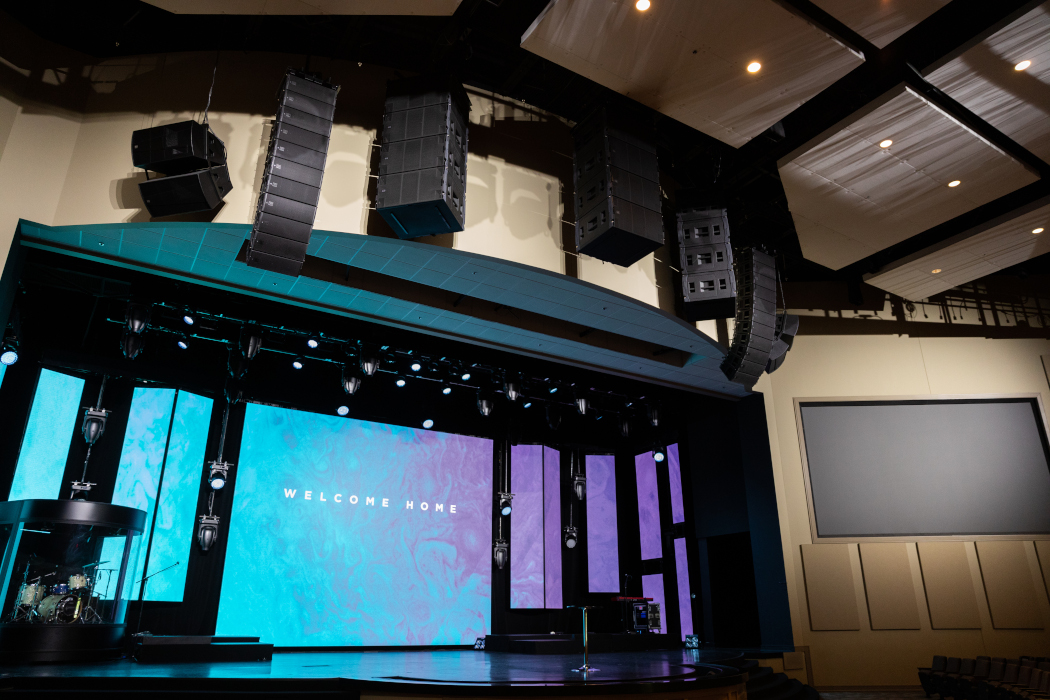
According to Clark’s Alex Stave, “The biggest challenge was just the fact that they have continual events in the space, so to take the old system offline while installing the new system—and then to get everything up and running—was a good challenge. That involved setting up a temporary system, getting them off the old system while installing the new stuff, and then getting everything transferred over while events were happening either every day or every other day.”
Stave continued, “The first stage of the install [focused on] the overall infrastructure, so [that included] getting all the conduit paths and electrical in. We put in a three-phase UPS to power everything and got that all set up, and then we did the cable pulls. After that was done, we got the temporary system set up and got them running on that. And as soon as that was going on, we started decommissioning the old equipment and pulling that out, then started working on installing the new equipment. And then after that, [we worked on] phasing in stuff from the temporary system and getting it into the final setup and configuration.”
In addition to handling power for the system, the universal power supply serves as an alternative to Church of the Highlands’ longstanding approach of relying on a backup PA system in case of a failure in the main speaker system. “Our backup plan up until this upgrade was speakers on sticks and a few wireless channels that could be used by the campus pastor, worship leader and [musicians], as needed,” Johnson explained. “This is a great solution and fit us very well over the years, but [the backup system] essentially was a life-safety system for communicating in the room and being able to facilitate a very light worship experience, if needed.”
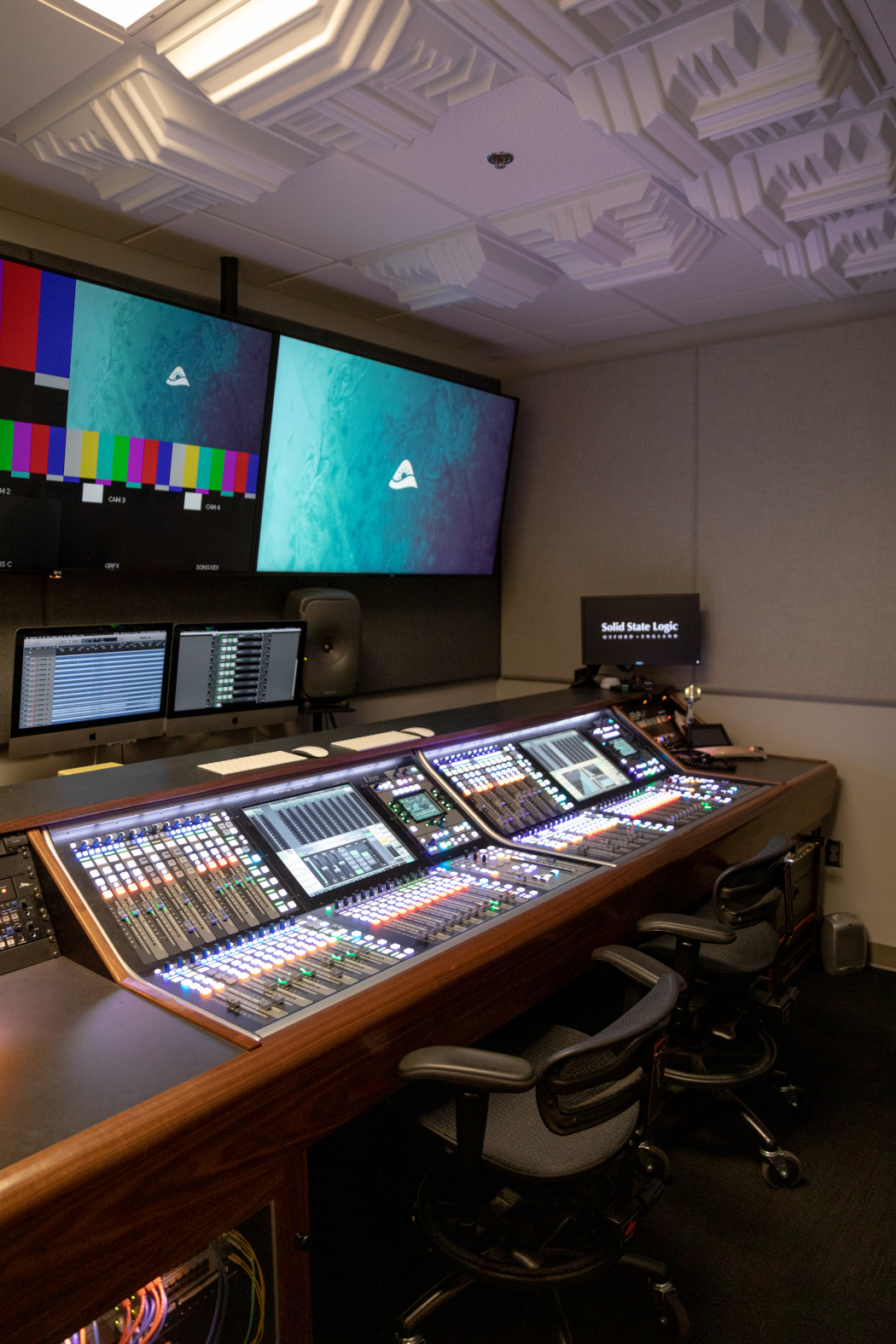
After crunching some numbers, the church leadership realized a complete-system UPS would be a more cost-effective solution than its traditional approach of installing a backup PA system. According to Johnson, “We did the math on individual UPS units that [could handle] all the computer equipment that was getting put in place. We made sure to include the complete cost of ownership of any power conditioners and UPS units, [including] battery maintenance, heat load and power consumption. We determined that a better, [more] cost-effective solution for our broadcast location was to put a whole-system UPS/power conditioner in line with the system. We installed a 480V, 60Hz, three-phase, 100kVA [Vertiv Liebert 51SA100ERA] UPS system in line with all of the mission-critical main-auditorium AVL and IT systems. It’s capable of powering everything needed to maintain broadcast origination in the main room and streaming to campuses, including the full PA. Having this unit in place conditions the power, provides a battery backup of all systems and will serve as a backup sound system, allowing full worship to continue on battery power for about 60 minutes.”
There is extensive BTX OpticalCON fiber infrastructure throughout the Grants Mill campus. “We ended up pulling both multi-mode and single-mode fiber throughout the room, as well as throughout the building,” Stave said. “The single-mode fiber is for network and video, and then the multi-mode fiber we are using for the SSL Blacklight connections. We’re using SSL Dante HC Bridges—we have five of those—and each of those allows 256×256 channels of I/O to each of the consoles from the Dante network at 96K.”
After the infrastructure and cabling was installed, the next major step was installing digital consoles in various locations throughout the broadcast campus. After demoing a number digital consoles, Church of the Highlands decided to choose Solid State Logic’s L500 Plus console. In total, there are five L500 Plus consoles in the venue—one is stored in mobile cart used for monitor mixing, two are located at the front-of-house mixing position and two are installed in the broadcast audio room (which is currently located stage left).
“They were really driven by sound quality, which is how we ended up with the SSL,” Stave shared. “They’re using them in three different locations: front of house, monitors and the broadcast room. At front of house, they’re using one L500 to mix, and then the second L500 they’re using basically as a fader-expansion rig, and they can fail over to that for redundancy if one console fails. And that’s the same in the broadcast room, where they’re using [the second console] for fader expansion as well as for the redundancy of having a second console available.”
Johnson affirmed that Church of the Highlands’ main concerns when choosing the audio consoles centered on sound quality and redundancy. “Quality was the first lens that we looked through when deciding on the new system components,” he explained. “Everything in the chain is designed to keep quality at its highest, so that the equipment could never be at fault when facilitating distraction-free services.” He continued, “We also needed a system that had redundancy to allow for a seamless transition if a failure were to happen. Each main component has a backup equivalent in place with a system of transition built in.”
In order to maximize system flexibility, Church of the Highlands’ broadcast campus features a wealth of digital audio inputs and networked infrastructure to ensure the church leadership’s creative freedom in designing unique stage setups and worship programming. Many of the system components live on an Aruba network, although there are still some analog I/Os throughout the venue.
“[The Aruba network handles] audio transport and audio control,” Stave explained. “Pretty much everything is living on the network, and we have around 1,400 channels of audio. We have a redundant primary switch network, we have a redundant secondary switch network [and we have] a device-control VLAN that’s on both of those. It’s 10-gig links between all the switches in a star configuration back to some core fiber switches, and we are running around a gig and a half of audio from the links. We chose Aruba 2530 switches, as well as 3810s for the core fiber switches.”
Increasing the number of audio inputs in the worship space was a major priority for this installation. “We added—primarily to the stage—around 120 inputs, and those are on custom sub-snake panels on the stage,” Stave said. “We also built custom snakes that include audio and network to drop boxes that they can place around the stage area. We added some additional analog I/O around the room in the ceiling catwalks for audience mics, as well as on the lip of the stage in some floor pockets.” The custom panels and snakes were made by Entertainment Metals.
Altogether, there are eight SSL SB32.24 Dante stage boxes installed in the venue. “To get the flexibility they wanted with all of the consoles having access to all of the inputs, it’s something that you can’t do easily with MADI stage boxes,” Stave explained. “We started out the install with MADI stage boxes because the Dante stage boxes weren’t available yet, and then, this last year, we switched them over to the Dante stage boxes.”
He continued, “There are quite a few channels of mic pres for inputs on the stage, and then we have Focusrite RedNet boxes throughout the building for additional I/O and tie lines. All the tie lines are no longer analog in the building; it’s all over the network. From the console, we’re running AES drive to a Martin Merlin processor, and then to the PA.”
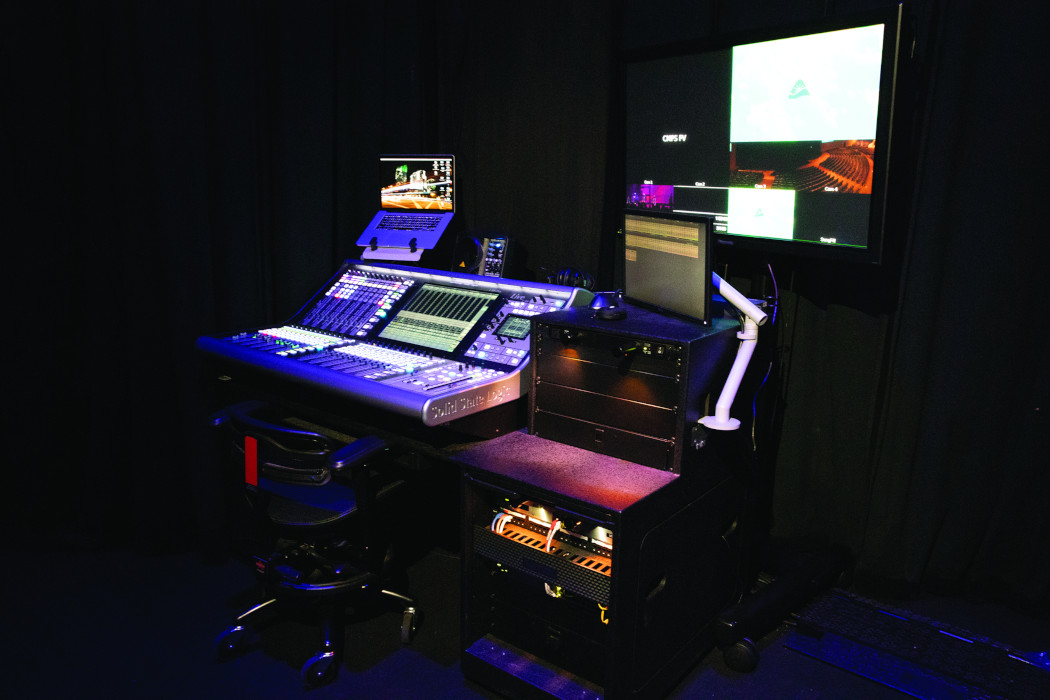
As part of the audio upgrade, Clark added a large number of Shure wireless channels for both microphones and in-ear monitors. Thirty-two channels of PSM 1000 in-ears are available. There are 24 channels of ULX-D wireless with a mixture of KSM9 handheld transmitters and ULXD1 bodypacks in use, although the church plans to upgrade to Axient Digital systems in the near future. Spaced throughout the venue are 12 Shure VP89L shotgun mics, which are used for crowd capture. The musicians and worship leaders also use a variety of preexisting DPA headsets and instrument mics.
Before upgrading the PA, Clark’s Tom Donohue conducted EASE modeling of the main auditorium to identify any problem areas in the room. Clark then brought in a few demo speakers, and ultimately the church decided to go with a Martin Audio MLA Compact system. The MLA system is a left/right configuration with 11 boxes per side. “The main [selling point] with the MLA system was being able to define your audience coverage zones, as well as hard-avoid the reflective surfaces using the DSP power of the box,” Stave explained. Clark’s Ed Crippen handled commissioning for the speaker system.
In addition to the main MLA Compact arrays, there are six Martin H3H+ speakers handling coverage for the far ends of the auditorium; four are flown above the stage, and two are used as delays. The PA system also includes 10 Martin CDD5B speakers that are used as front fills for the first few rows of seating near the stage.
Low-frequency sound reproduction is handled by an array of 12 Martin MLX subwoofers. Figuring out the low end was somewhat of a challenge, so Clark demoed two options for the placement of the subwoofer array. “The challenge was that they didn’t want to have to rebuild the stage, as normally we’d do a horizontal sub array in that situation,” Stave said. “So we actually did a full demo of a sub array on the ground while also having a sub array in the air, so the church could decide if they were OK with doing a flown sub array.” After the demo, the church decided to move ahead with the flown array.
The H3H+ and CDD5B speakers are powered by two Martin IK81 amplifiers, whereas the main MLA Compact arrays and the MLX subwoofers are self-powered.
Although the MLA Compact arrays are using their own internal DSP, there is a QSC Core 510i Q-SYS processor in use, as well as four Waves SoundGrid Extreme servers. “The QSC DSP is handling audio routing for audio from video, as well as their [preexisting] distributed audio system,” Stave explained. “The Waves SoundGrid servers are for redundant servers at front of house and broadcast, and those are running Waves MultiRack plugins.” The Waves Sound-Grid servers live on their own dedicated Cisco network.
Audio capture is handled by a pair of TASCAM SDR-250N recorders; one is located in the broadcast audio room and one is located at front of house.
Several computers are used to run software throughout the Grants Mill campus. Technicians can interface with the audio system in the broadcast audio room, at the monitor mixing location, at the FOH mixing location and via the main equipment rack in the core rack room.
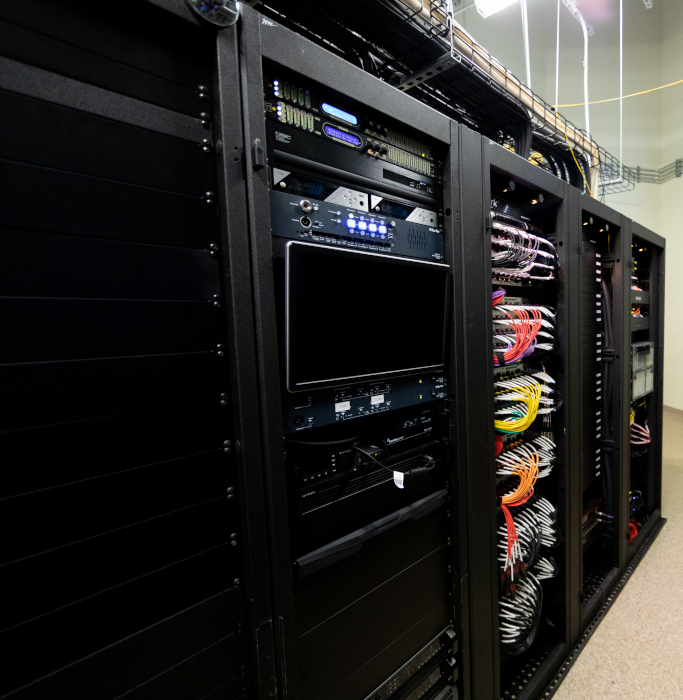
“There’s a rackmounted SuperLogics control computer in the main equipment racks that runs Dante Domain Manager,” Stave said. “That’s located in their core rack room, which is where our main audio I/O racks are located, as well as amplifiers. You have the ability to remote into anything from there, but, for the most part, they have all of their audio I/O for the stage and the core network switches, and some of the SoundGrid DSP processing equipment is back in that rack.”
Stave continued, “The rest [of the control computers] are Macs. Right now, they have three at front of house, one at monitors and two in the broadcast room. [In the broadcast room,] one is running Waves Tracks Live multitracking software, and the other is running the Waves MultiRack plugins. [At front of house,] one is for tracking, one is for Waves SoundGrid and one is for background music playback.”
In addition to adding flexibility to the main auditorium, Church of the Highlands wanted to give the technicians in the broadcast audio room the ability to mix audio inputs in the Grants Mill campus’ chapel and theater, with everything tied together over the Dante network. “We used their existing Avid desks in [the chapel and theater] and we took MADI outputs to Focusrite RedNet B64s to get them on the audio network and to make them available at the broadcast consoles,” Stave explained. “Now they can mix all those inputs in the broadcast room.”
When the audio system upgrade was all said and done, Church of the Highlands had achieved its goal of improving its system flexibility and streaming capabilities. This means the church’s ambitions are no longer limited by its technology, and there are more possibilities for expanding Church of the Highlands’ ministry than ever before. For Johnson and his team, the difference between the old system and the new system is night and day.
“After 10 years with the originally installed system, combined with the explosive growth of Church of the Highlands and the amazing teams, [whose members] invest in worship, songwriting, original content [and] creative elements—all the needs of a dynamic, life-breathing church—we found ourselves having to spend countless hours prepping and designing systems that were hindered by technology,” Johnson shared. “The upgrade to a digital audio system was a necessity, and Dante has been amazing. The answer has become always ‘yes,’ with little need to think about how to do anything. The systems are in place for anything that our church needs…for the time being.”
He continued, “The overall quality in the room has improved drastically. We’re very pleased with the system upgrade of the PA and the console infrastructure. The Dante infrastructure is one of the highlights of the installation. The ability to get any source, to any location, at any time, with the click of a mouse or patch in the console is a game-changer. It adds great value to the worship experience. One of the main [bits of] feedback [we’ve received] has been the uniform distribution of sound in all locations of the room and the consistency of that sound [from] any seat. The broadcast leg of audio has never been better. We are now able to send multiple audio channels to campuses, putting individual control of broadcast sources down at the campus level. This allows us [to have] campus-level control of crowd mics, pastor mics, vocals, etc., and allows each location to shape the streamed content that is produced from one broadcast location in a way that fits the needs of each campus’ room.”
The system upgrade has left Johnson feeling optimistic about the future of worship programming at Church of the Highlands and the sharing of content and workflows between the broadcast campus and the satellite campuses. “We are constantly tinkering on what is next and how we can be ready for it,” he explained. “We are experimenting with using the power of Dante over our church-wide switched Ethernet circuit to directly send audio from campuses that are in totally different locations across the state of Alabama. Dark fiber is always an option, but that gets inefficient when you are talking about locations that are on completely different geographical ends of the state. We have had great success with extremely low-latency audio transport of multiple Dante streams using our switched Ethernet, with minimal switch configuration, and that rides on the same connection as the live video stream to campuses, VoIP and email. Dante Domain Manager is what allowed multicast traffic to traverse networks as unicast streams, and it is the key to this idea. The vision for this experiment is, potentially, to allow us to have one broadcast studio at a central location and to transport multichannel Dante audio from any campus location, in low latency, back to a single broadcast studio. I enjoy dreaming and being able to say yes to things that are just crazy. This could be one of those, and I am super excited about the possibilities!”
